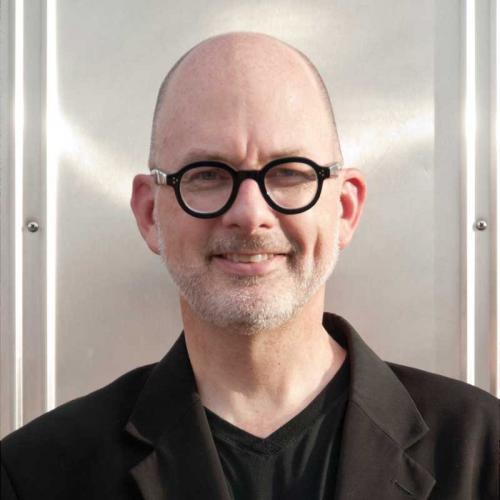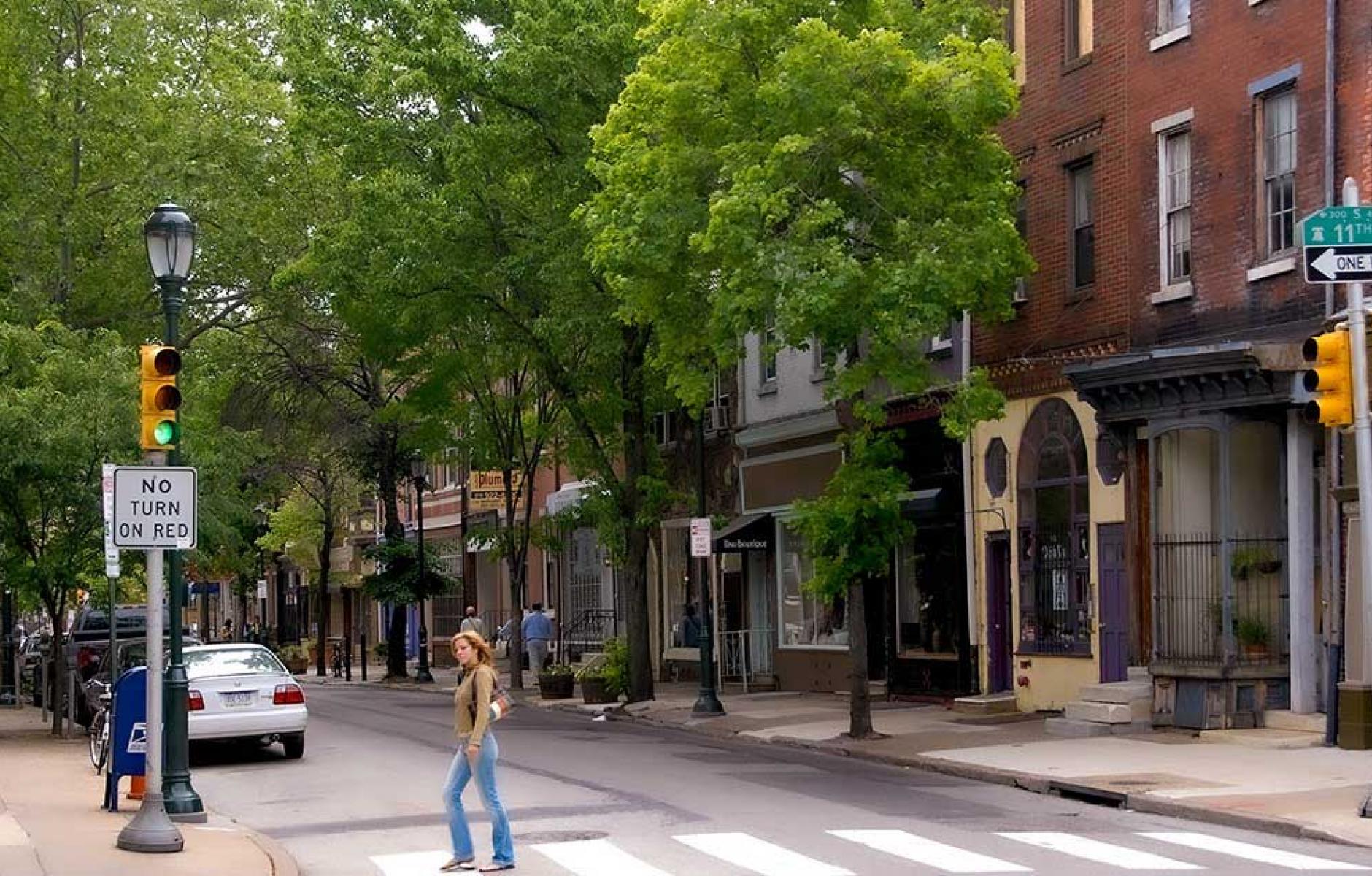
The powerful virtuous cycles of street trees
There are several powerful virtuous cycles of street trees that benefit so many parts of the built environment and the people who inhabit it in ways we may not have thought about until now. This post daylights the multitude of benefits—some of which are life-changing. And from 2020 onward, as we look for the healthy benefits of spending more time outdoors, no single element will play a larger role in helping us to do just that than street trees.
Direct effects of street trees
Street trees affect us directly in many ways. These effects are arranged below from the most local to the global.
Thermal effects: Properly placed street trees shade the sidewalk. This can result in a reduction of 20°-45° (all temperatures Fahrenheit) in sidewalk temperature, according to architect Lance Hosey. Sidewalks store a lot of heat due to their mass and then radiate that heat to everything around them, especially including the people walking on them.
Street trees also shade the people walking on the sidewalk. Walking in the shade versus walking in the sun can easily make a perceived difference of 20° due to solar radiation on your skin.
Street trees transpire, meaning that they give off water vapor through evaporation of moisture from their leaves. The misting fans often found in warm climates like South Beach where we lived for 16 years cool people sitting at sidewalk cafes have a similar and more visible effect because you can see the mist whereas you can’t see the water vapor from the trees, even though it cools you almost as well. Evapotranspiration from trees can reduce temperatures around the trees by 2° - 9°, again according to Hosey. This compounds the cooling effect of shading.

Beauty: Street trees are usually considered beautiful by most people in town. And street trees are the only things we install on a streetscape that get bigger and more beautiful over time all on their own. But beauty isn’t the only way they appeal to our senses. “Street trees help you know when you are because of how they behave across the seasons,” says urban designer Victor Dover.
Safety: Properly placed street trees (between sidewalk & travel lanes) physically protect people walking on the sidewalk because a car is likely to strike a tree before getting to someone walking. Trees near the street also encourage drivers to slow down because no sane driver wants to wrap their car around a tree, as the tree almost always wins. Street trees have been shown to be as effective against speeding as speed cameras, according to The Telegraph.
Increased real estate value: Because street trees are beautiful, they raise the value of the real estate around them if properly selected. On mostly residential streets, their lowest limbs should be above head height; on mostly commercial streets, their lowest limbs should be above the sign band of the adjacent businesses. As to the value, one street tree on a block raises the value of every house on the block by $2,000 except the house where the street tree is located, the value of which is raised $7,000. If the street is lined with trees, the value of every house is raised by $22,000. This data is from Doug Kelbaugh. Dan Burden says that while the planting & 3-year maintenance cost of a relatively large-caliper street tree is probably $250 - $600, the lifetime benefits of that tree will be around $90,000. This means that street tree programs can be largely self-financing in all except poor neighborhoods because once people understand this, many will plant their own street trees to jump-start their home appreciation. Beyond the street, studies show home buyers & real estate agents assign 10%-23% of lot value to trees on the lot, according to Kaid Benfield.
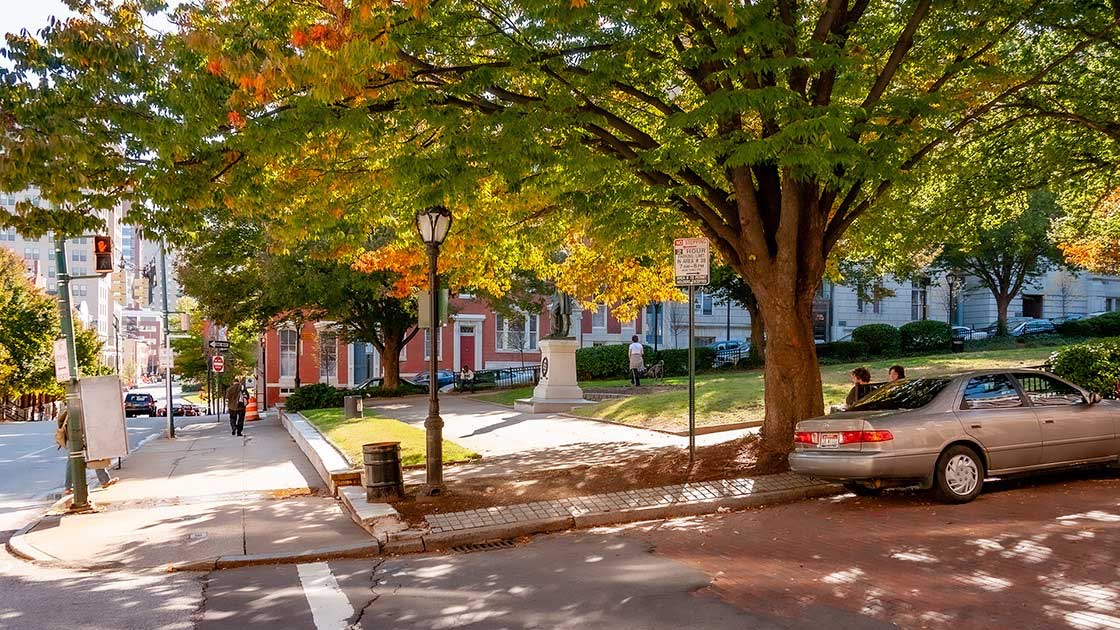
Crime reduction: Street trees reduce crime. A recent Baltimore study showed that 10% more street trees = 12% less crime. Why this is so is no mystery. More street trees = stronger Walk Appeal = more people walking = more eyes on the street = less crime, as Jane Jacobs said 60 years ago.
Indicator of places people love: Because street trees are beautiful, they are good indicators of the most-loved parts of town, increasing not only the real estate value, but also the stature of the neighborhood. Recovery of a seriously disinvested place should begin early on with a street tree program because street trees change the perception of the place from a place where nothing is possible to a place where “you never know what good might happen here.” When I’m scouting a town I’m not familiar with for possibly shooting a volume for the Catalog of the Most-Loved Places, I drive a major street and look down the side streets looking for street trees. Almost without exception, places with lots of street trees are the most-loved neighborhoods in town. No other sign of a vibrant, lovable place can be seen from further away than a line of street trees. Test this yourself.
Business improvement: Street trees are good for business. Lining streets with street trees leading to a neighborhood center draws customers in to neighborhood businesses from surrounding neighborhoods by elevating Walk Appeal. Jeff Tumlin says that street trees are a critical economic development and sustainability investment. And they’re good for the economy of a neighborhood in general. According to Patrick Kennedy, Every street tree absorbs the first inch of stormwater. They can save billions in stormwater infrastructure across the city, allowing that money to be spent on things that benefit businesses. Or the money can be saved so that taxes can be reduced.
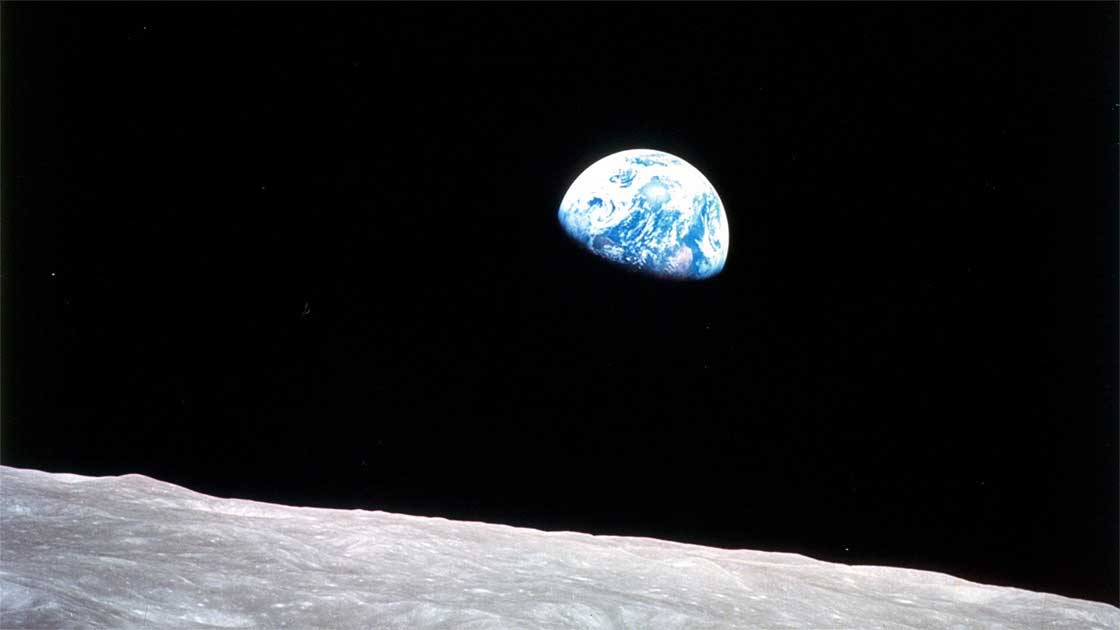
Global effects: Trees are carbon champions. They continually inhale carbon dioxide and exhale oxygen, while humans and other animals do the opposite. They also sequester carbon within the tree as the tree grows. Plant enough trees, and they will actually absorb all carbon emitted by humans today. That number is currently 1.2 trillion trees. Unfortunately, humans are going the wrong direction by burning the Amazon and deforesting places around the world for more cattle farming. But planting street trees would at least be a start in the right direction. If there are 4 million miles of streets and roads in the US today (not counting Interstates) and street trees were planted 25 feet on center on either side of all of them, that would total almost 1.7 billion trees. That’s only a fraction of 1.2 trillion, but definitely a step in the right direction. Just. Quit. Destroying. What’s. Already. Growing!
Secondary effects of street tree virtuous cycles
This is without doubt a partial list, and might even be just the tip of the iceberg.
Walk appeal superfood: The combined effect of shading the sidewalk, shading the humans, and evapotranspiration can transform a walk in hot weather (wearing anything other than beach attire) from something 10% of the people can tolerate to something 90% can tolerate, making street trees a Walk Appeal superfood. One young healthy street tree = the cooling power of 10 room-size air conditioners running 20 hours/day, according to Kaid Benfield. And Doug Kelbaugh says street trees have close to 16 times the cooling effect on the human environment as trees in a forest.
Urban heat island reduction: For all the reasons already listed and because street trees also shade a lot of paving on the streets themselves, they are major contributors to reductions in urban heat islands. For anyone who might not know the term, “urban heat islands” describes the heating of air within cities to several degrees above that of the surrounding countryside. And according to Ed Mazria, each 10% increase in tree coverage in an urban context can reduce mid-day temp by 1.8°.

Sidewalk café enrichment: Street trees at sidewalk cafes make them more comfortable, thereby attracting more customers, which in turn increases the cafes’ chances of success which in turn builds the financial strength of their suppliers and provides a livelihood for their employees.
Adjacent building conditioning reduction: Deciduous street trees on narrow streets shade windows of adjacent buildings, reducing cooling loads. And by being deciduous, they drop their leaves in autumn, allowing solar gain into the buildings during the colder months of the year.
Improved perception of surrounding environment: Because street trees are beautiful, they improve the environment around them in many ways. For example, almost everyone loathes parking lots, but Victor Dover says that the greatest parking lot in the world is the Champs Élysées in Paris. And it works because of the street trees.
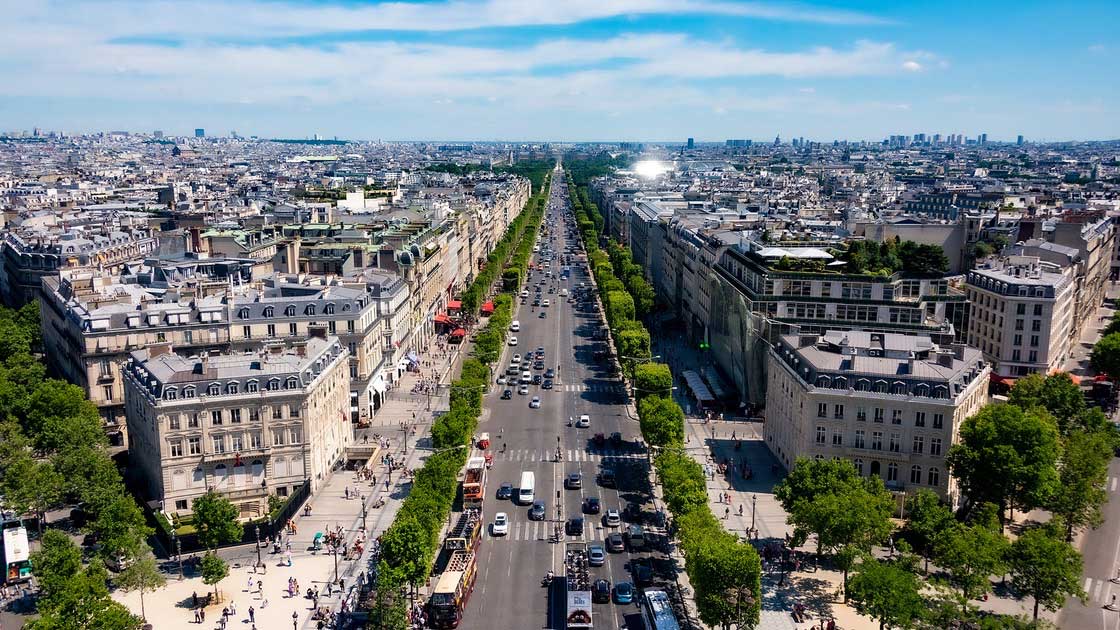
Increased perception of safety: Perception of safety is a strong component of Walk Appeal. The perception of protection from traffic afforded by street trees (see Safety above) combined with the perception of the neighborhood as a most-loved place due to the street trees has strong compounding effects in elevating Walk Appeal.
Improved performance of surrounding environment: Street trees improve the local environment in several ways due to combinations of several of the direct effects noted above. Doug Kelbaugh says that street trees are like little urban hospitals. They beautify their surroundings, freshen and oxygenate the air, reduce aerial pollutants, provide cooling shade, retain soil, and detain & retain stormwater, among other benefits.
Improved wellness of body, mind & spirit: All these things raise a sense of wellness and wholeness in those who are there, which have beneficial side-effects on our wellness of body, wellness of mind and wellness of spirit. And there’s one very direct result of Walk Appeal that benefits all three types of wellness: Both folk wisdom and scientific studies have shown that there is a direct relationship between walking and both clarity of thought and peacefulness of mind, which also contributes to wellness of body by reducing blood pressure and pulse rate, and improving many other bodily metrics. But long before the studies, folk wisdom set a high value on “thinking on your feet.” Many agree. Steve Jobs famously developed some of his best ideas on long walks.
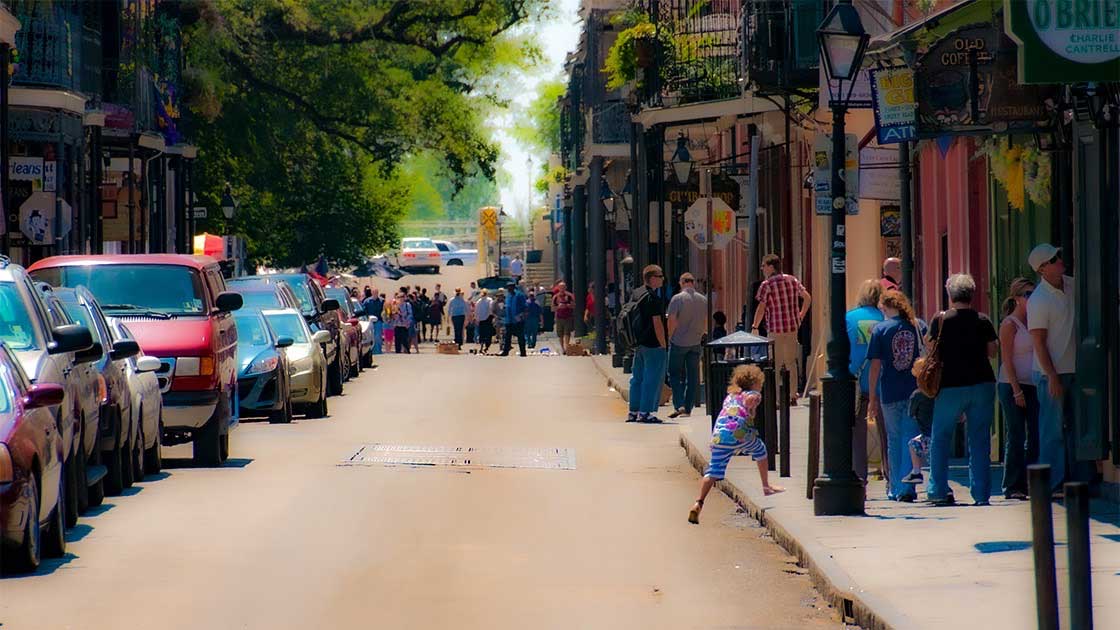
Improvement of disinvested places: Increases in real estate value as a result of street trees have beneficial side-effects across the board, but nowhere are these benefits more pronounced than in seriously disinvested places because greater value opens the doors for banks to provide the resources necessary for further improvements. But increases in value have a dark underbelly, which is gentrification with displacement. The old aphorism says “a rising tide lifts all boats,” but most of the time, a rising tide creates enough draft for the cruise ships, so the little boats have to leave. Increased value could be handled this way (and usually is) but doesn’t have to be. If the goal is changing lives rather than just changing structures & infrastructure, then transforming a barren street to a tree-lined street should be one of the first steps in turning a neighborhood around because they can lift the spirits of those who live there, helping things seem possible which seemed impossible on the barren street nobody cared for.
Reduction in crime due to more street trees has many benefits to any neighborhood, especially the most disinvested neighborhoods. Crime stifles normal social interactions, which are the seedbeds of community bonds, and saps the economic strength of a place, both due to fear of the public realm. Reduction in crime makes many things possible that seemed impossible beforehand.
Walk appeal & single crew workplaces: Street trees set the stage for thriving single-crew workplaces because the workplaces are too small to survive without healthy foot traffic. Single-crew workplaces are rarely destination retailers. Walk Appeal and single-crew workplaces such as food carts have a strong symbiotic relationship. Few things feed Walk Appeal more than the combination of quick changes in view and other humans, and a line of food carts or shop sheds provides this in spades. And nothing feeds single-crew workplaces better than many people walking by.
Tertiary effects of street tree virtuous cycles
The tertiary effects of street trees might even be even more the tip of the iceberg than the secondary effects. I have for years been trying to figure out something Orjan Lindroth and I call the “unified field theory of sustainable community,” We’re no Einsteins, but similar to how Einstein’s unified field theory of natural forces (that he worked to discover to the end of his life) would have been able to express every force in terms of every other force, our hope is to be able to express every part of the built environment and the societies that inhabit it in terms of every other part. We were finally able to tell a lot of the story in the new edition of A Living Tradition [Architecture of The Bahamas] a couple years ago once we finally figured out that the operating system is composed of nature’s ways rather than industrial rules. But these virtuous cycles (especially the tertiary effects and beyond) do the best job of laying out the story of how it works that I’ve ever been able to tell. Or at least I think so. I’d love to hear your thoughts.
Living in-season: Walk Appeal entices people to spend time outdoors, either attending to their daily needs or just for the pure joy of walking in a place with great appeal. In either case, time spent outdoors helps acclimate us to the local environment so that on all but the most extreme days of the year, it may be possible to throw the windows open instead of turning on the equipment, and there is no equipment so efficient as that which is off. This is a condition I call Living In Season. Wanda and I have proven this personally. Because we arrived in Miami in the fall of 2003, we spent our first months there in the “winter,” such as it is, and got acclimated to warmer weather slowly in the springtime. As a result, I can accurately say that in all of my 16 years living on Miami Beach, I have never been in the shade, in a breeze, and uncomfortable. Not once. But when people came to visit who lived in a perpetually refrigerated existence, they really suffered. Waves of sweat rolling off them. Meanwhile, I have many times worked in my studio on Miami Beach in July, with the windows open, the ceiling fan on, and the AC off. In the town where the basketball team is named “the Heat.” This isn’t theory; for us, it is practice.
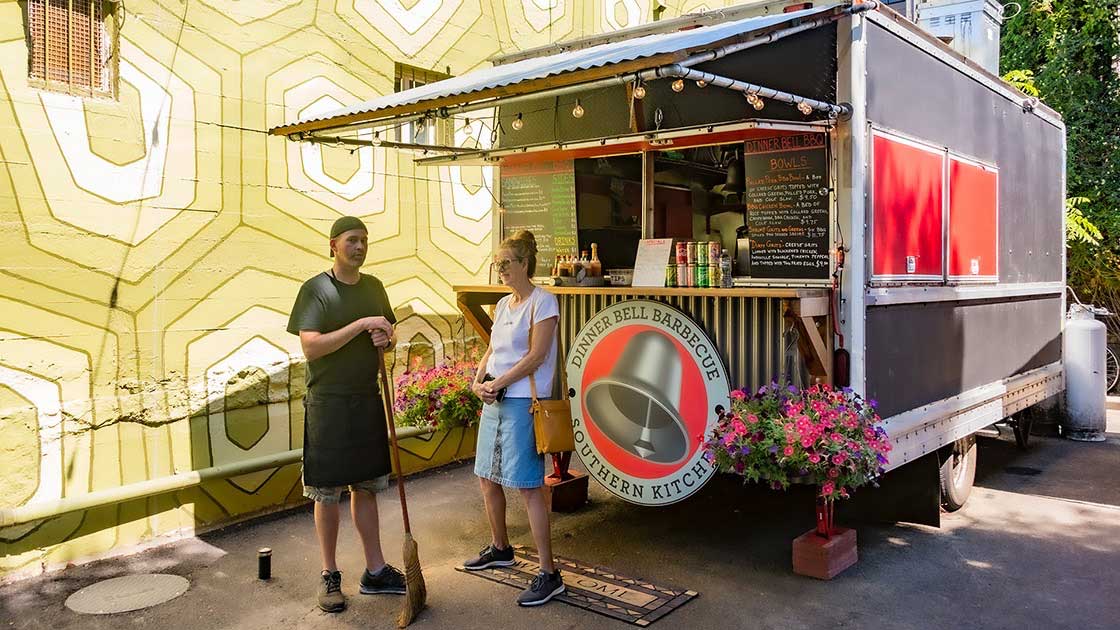
Fine-grained web of daily needs: Single-crew workplaces fueled by street trees and their resultant Walk Appeal are the best tools for meeting a full range of daily needs in a neighborhood, especially a seriously disinvested one. There’s no need for a 40,000 square foot grocery; I have photos of a 16’ x 36’ single-crew grocery (one grocer) in Beaufort, South Carolina that opened in 1919 and has been in the family ever since. Without it, that neighborhood would have been a food desert. Put another way, if the smallest viable grocery is 40,000 square feet, everyone has to drive so all the neighbors in that neighborhood would be burdened with the cost of owning a car. Single-crew workplaces are a strong answer to the specter of automotive impoverishment.
Building dreams early: Single-crew workplaces have another remarkable property: they make it possible for people of more limited resources like women, the young, immigrants, and minorities (groups Lean Urbanism is working to benefit) to begin realizing their dreams years or decades before they could afford to go in business in a conventional ULI-approved brick-and-mortar location. If they ever could at any time in their lifetime. The self-determination of pursuing one’s dream was always the real American Dream, right up until it got hijacked by the real estate industry and rebranded as owning a house. Single-crew workplaces can set that straight again.
Obesity reduction: Street trees reduce obesity by elevating Walk Appeal so people are enticed outdoors to walk instead of drive. Doug Kelbaugh puts it directly: “the more trees there are on a block, the less likely people living there are to be obese.” Walk Appeal has three prime benefits: elevating the environmental health, the economic health, and the public health of a place. While the first two benefit greatly from Walk Appeal, arguably the greatest beneficiary is public health, as Walk Appeal can add meaningful years to our lives. But we’ve known this dating back to Dr. Richard Jackson’s pioneering work over a decade ago.

Parking reduction: When street-tree-fueled Walk Appeal is stronger, there is less need for parking at single-crew workplaces because they can be more finely distributed around the city and the neighborhood so that more people can walk to their daily needs. Reducing parking, especially off-street parking lots, has many benefits. A parking lot paved in asphalt is a huge heat sink, elevating the temperature of the microclimate around it. Parking lots located at the street frontage nearly kill Walk Appeal for two reasons: they are really boring and they are also repulsive. How many people do you know who say “I love parking lots?” They also prevent proper street enclosure on their side of the street. And whereas the travel lanes of streets with on-street parking double as parking aisles but parking lots must provide their own aisle, the asphalt required per car is essentially doubled once you count access drives, doubling the harmful heat island effects per car. Actually, I could go on for quite some time on the harmful effects of surface parking lots, but then I wouldn’t finish this post this evening.
Driving & heat island reduction: More walking to daily needs means less driving, and there are more benefits to driving less to daily needs than just needing less parking. The heat of combustion from automobile engines exacerbates urban heat islands. Cities & towns where people drive more get hotter; cities & towns where people drive less stay cooler.
Air conditioning & heat island reduction: More severe heat islands raise the cooling load on buildings because the air around them is hotter. Unfortunately, air conditioning operates by expelling indoor heat to the outdoors. Stand next to a condensing unit to feel the effects. This is a clearly vicious cycle, because as the urban heat island gets more severe and necessitates more indoor cooling, the heat that is expelled makes outdoor air even hotter, requiring even more cooling. The net effect of the supercharged urban heat island is that people who could otherwise walk to their daily needs drive instead, because it’s just too hot to walk, and that additional auto exhaust further heats the air, reinforcing the vicious cycle. Under these conditions, Living in Season eventually becomes impossible. The first step in unwrapping this vicious spiral is more street trees, which with the many intertwined effects noted so far, can cool the city enough to restart the virtuous cycles.

The enticement of other humans: I mentioned sidewalk cafes earlier. Nothing is more interesting to humans than other humans. That’s why it’s so interesting walking on a busy sidewalk. There is one thing more interesting than walking humans, and that’s humans sitting still in one place for some time. You might see a person walking by for a few seconds, whereas they might sit at a sidewalk cafe for hours. Sidewalk cafes are one of the silver bullets of urbanism, with too many befits that ripple out from them to describe here. Suffice it to say that if there is a thriving cafe scene in a neighborhood, many other good things are probably happening there as well.
Porches, galleries, balconies & neighborliness: The second most interesting place for humans to sit is on porches, galleries, or balconies located in such a way that they can strike up a conversation with someone walking by who was theretofore a stranger. And as hokey as it sounds, it’s also true that those conversations can lead to relationships, which can then lead to people acting like neighbors again, rather than as the more common status as anonymous co-habitators of nearby real estate. But that only works if there are people walking by, which is highly dependent on Walk Appeal and the street trees that boost it so.
Local to global benefits: Let’s get back out here at the end to the global scale: Street trees elevate Walk Appeal which in turn reduces urban heat islands. All this conspires to make a community a more pleasant place to live where you can walk to your daily needs, become more fit and reach greater clarity of mind and peacefulness of spirit. And you can meet more neighbors and become as deeply invested in your community as you like, while seeing your neighbors pursue their dreams that would have been impossible elsewhere because of their single-crew workplaces in your neighborhood which by the way gives you more choices of services within walking distance. Or maybe you become one of them, pursuing your dreams as well.
But there’s more. All of these things conspire to help mitigate climate change, which millions view as civilization’s greatest threat. But maybe you don’t; there are millions from the US to Australia who share that view. If you share that view, just focus on the local things you enjoy about living this way in your neighborhood and your town. If living this way has global benefits far beyond your neighborhood or your town, we all win. All you have to do is start planting street trees and enjoy them and the many powerful virtuous cycles that spin out from them.




